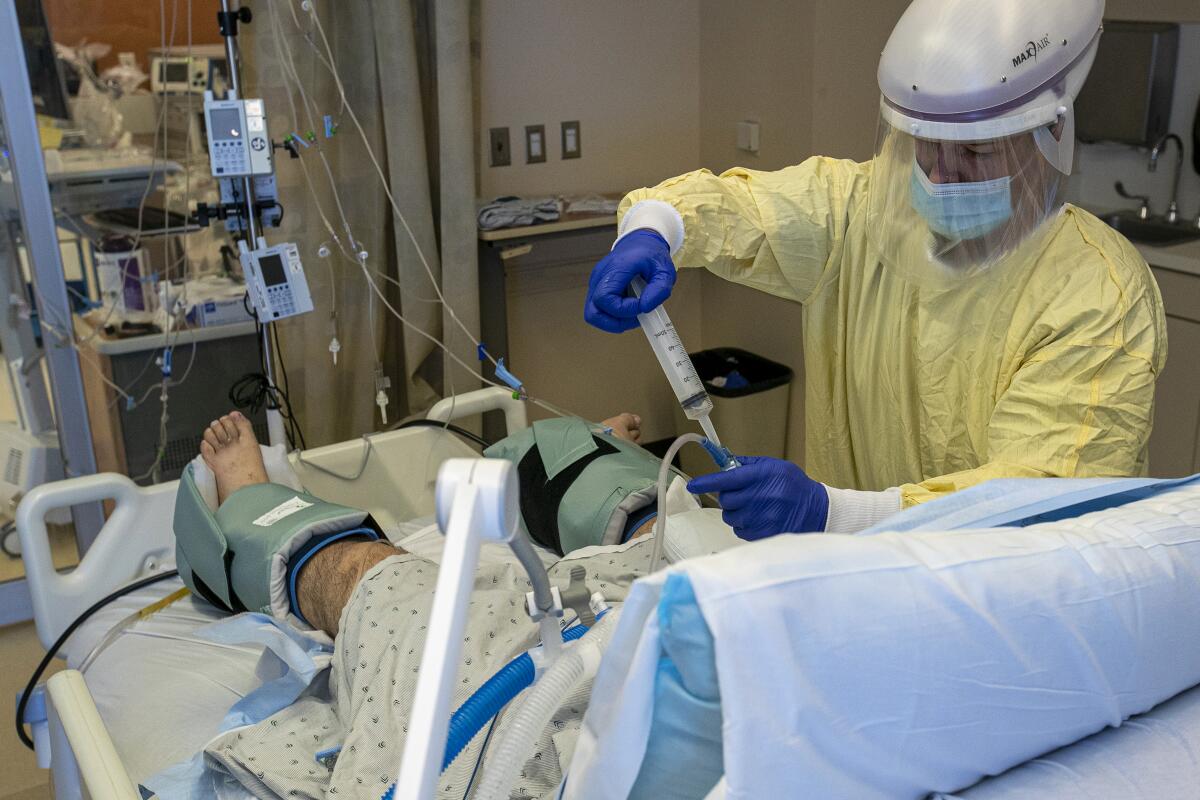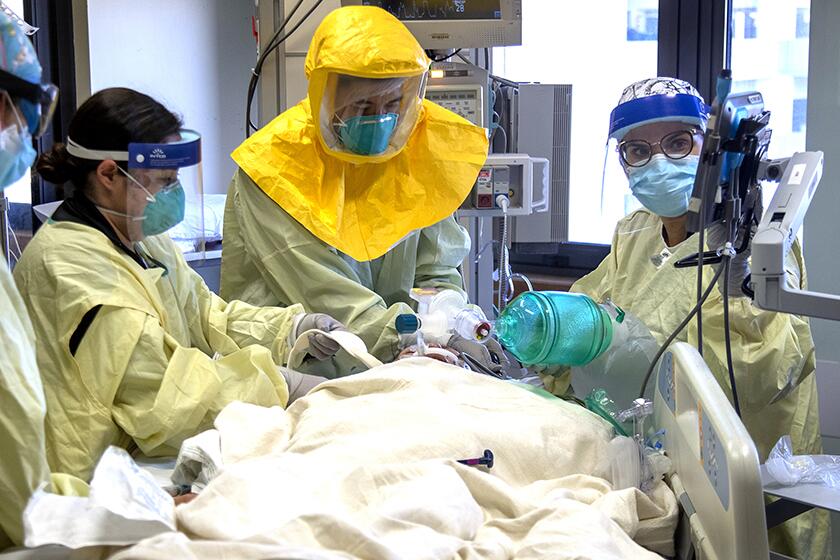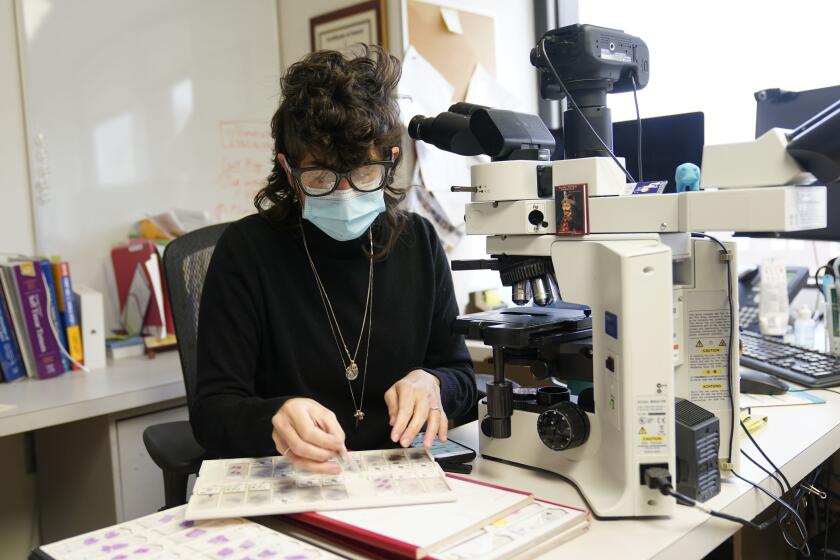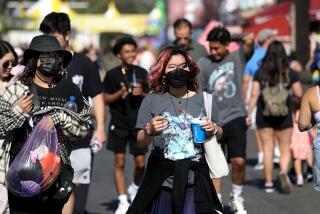Stay-at-home order for much of California extended amid COVID-19 overload at hospitals

- Share via
Southern California will remain under a stay-at-home order for the foreseeable future, state officials said Tuesday, meaning the region will enter 2021 with significant restrictions on its struggling economy as hundreds of Californians die every day and hospitals face unprecedented pressures from a flood of COVID-19 patients.
While not unexpected, Tuesday’s extension of the stay-at-home order for both Southern California and the San Joaquin Valley is yet another cold splash of reality that the pandemic will upend life into the new year, despite the promise of the new vaccines.
Restrictions on businesses, especially the ban on outdoor restaurant dining, were increasingly unpopular among some as the pandemic dragged into its third wave, before the severity of the hospital crisis became clear.
As the coronavirus has rapidly spread over the last two months — sparking an alarming rise in deaths, which are now occurring in California once every six minutes — there are finally signs that the rules that went into effect three weeks ago are offering some relief.
While total cases and hospitalizations continue to set new daily records, the pace of growth has slowed. The average number of cases reported statewide has fallen slightly from a peak of about 45,000 a day for the weeklong period that ended Dec. 22 to about 38,000 a day by Monday night.
California’s hospitals remain in crisis, but the daily increase in COVID-19 hospitalizations has also eased recently. Net hospitalizations rose by an average of 113 every day for the weeklong period that ended Dec. 19. For the most recent comparable period, the net increase in hospitalizations was 79 a day.
The crisis is striking some areas of the state harder than others.
Southern California and the San Joaquin Valley remain in the COVID-19 red zone, with 0% available capacity in their intensive care units. But in the Bay Area, officials believe pandemic-related restrictions have stabilized the region’s remaining supply of available ICU capacity, which has been hovering around 10%.
The Greater Sacramento region is even better off, with ICU availability stable at 19%.
As a result of the stay-at-home order that went into effect on Dec. 6, San Francisco’s public health department estimates that more than 500 deaths have been prevented, along with an even greater number of hospitalizations.
But these gains might be short-lived, as officials throughout California fear the state will have to wrestle with a new wave of infections stemming from gatherings and travel around Christmas and New Year’s. The ramifications of choices Californians make for those holidays will not become clear for another week or two.
The regional stay-at-home restrictions in Southern California and the San Joaquin Valley will be relaxed as soon as the available ICU capacity in a region, forecast four weeks out, meets or exceeds 15%, said Dr. Mark Ghaly, California’s health and human services secretary. There are four factors that go into the calculation: available ICU capacity, the rate of ICU admissions, the seven-day average coronavirus case rate and the virus transmission rate.
Health officials beseech the public to follow COVID restrictions, and a new January surge linked to winter holiday gatherings is feared.
California on Monday again recorded its highest number of new coronavirus infections in a single day, 66,811. Though that tally included a backlog from the long Christmas weekend, during which many counties did not issue reports, officials have said they expect that in the coming weeks there will be another surge in new infections stemming from gatherings and travel over the winter holidays.
Any significant spikes in coronavirus cases, experts warn, will invariably trigger a corresponding increase in the number of people needing to be hospitalized two to three weeks later. Hospitals statewide are already caring for more than 20,000 coronavirus-positive patients, the greatest number since the pandemic began. About 12% of people with diagnosed coronavirus infections will need to be hospitalized, and 12% of those patients will need ICU care.
“Frankly, many of the hospital leaders that I’ve talked to in Southern California are bracing for exactly that: a significant surge, a significant need to not only deal with what we’ve seen up until now, but an even more extreme condition in the middle and second part of January,” Ghaly said.
The number of people with COVID-19 inside ICUs has broken records for 16 consecutive days.
The state-defined Southern California and San Joaquin Valley regions have been under the latest stay-at-home order since Dec. 6. The orders are put into place when a region’s intensive care unit bed availability falls below 15%.
Those regions cover a combined 23 counties that are home to the bulk of California’s population: Imperial, Inyo, Los Angeles, Mono, Orange, Riverside, San Bernardino, San Diego, San Luis Obispo, Santa Barbara, Ventura, Calaveras, Fresno, Kern, Kings, Madera, Mariposa, Merced, San Benito, San Joaquin, Stanislaus, Tulare and Tuolumne.
San Francisco and four other Bay Area counties also decided to implement the regional stay-at-home order around the same time. The state imposed the restrictions in the Greater Sacramento region on Dec. 10, and the holdout Bay Area counties were required to implement the order on Dec. 17.
Officials have said the most recent round of restrictions — which include reduced capacity at retail stores; the closure of some businesses, including hair salons, nail salons, card rooms, museums, zoos and aquariums; and a prohibition on most gatherings, hotel stays for tourism and outdoor restaurant dining — are aimed at armoring hospitals against a torrent of COVID-19 patients.
Only rural Northern California, with 28% available ICU capacity, is not subject to the additional rules.
In L.A. County, hospitals are so overcrowded that some have had to convert conference rooms and gift shops into patient care areas. Others report such high demand for oxygen by COVID-19 patients that they’re having trouble maintaining air pressure in the pipes or experiencing shortages in supply.
“Whether or not we can eventually increase our ICU capacity to an adequate level is up to the behaviors of Los Angeles County residents — and the residents of all Southern California,” Los Angeles County Supervisor Hilda Solis said in a statement Tuesday. “COVID-19 cases are not limited to the borders of one county.”
Ghaly compared the situation facing hospitals to a rubber band: It can be stretched, but eventually there’s a breaking point.
“If you stretch far enough, certainly the ability to address all of a patient’s needs — to address the demands of new patients — becomes harder,” he said. The quality of healthcare provided has suffered because of how much hospitals have been overwhelmed, he added.
Ghaly said the plateau in average new daily coronavirus cases could offer a slight respite. But officials have said they fully expect that hospitals will get hit by a mid-January wave of patients who were infected at Christmas and New Year’s gatherings, underscoring the importance of even a small dip in infections now.
“We’re pleased to see a little bit of a plateau,” he said. Without this flattening, “the impact that we anticipate coming from Christmas [and] New Year’s would be even worse.”
That’s all the more reason to show that many new coronavirus infections, hospitalizations and deaths can easily be prevented if people stay home and forgo gatherings outside their household for New Year’s, he added.
“Much of what we’re dealing with is avoidable,” he said. “Much of what we are seeing can be stopped, if we collectively make decisions to stop it.”
L.A. County health officials last week urged the film industry to pause its work and refrain from traveling because of the COVID-19 surge. CBS Studios is delaying the resumption of production on a few of its shows that are on winter hiatus by a week, to Jan. 11, according to a person familiar with the matter who declined to be named.
The average daily number of new coronavirus cases has also begun to flatten in L.A. County, generally hovering near 14,000 a day over the last 12 days.
County officials warn, however, that for hospitals to become safer, the caseload needs to level off at a significantly lower point.
A tally of 14,000 to 15,000 cases a day “is way too high for us to take any solace in,” L.A. County Public Health Director Barbara Ferrer said last week. “We’d have to level off at a much lower rate for us to protect our hospitals.”
The COVID-19 pandemic has revived the autopsy at many hospitals. The procedure has helped doctors understand what the coronavirus does to patients’ organs.
Times staff writer Wendy Lee contributed to this report.
More to Read
Sign up for Essential California
The most important California stories and recommendations in your inbox every morning.
You may occasionally receive promotional content from the Los Angeles Times.



















